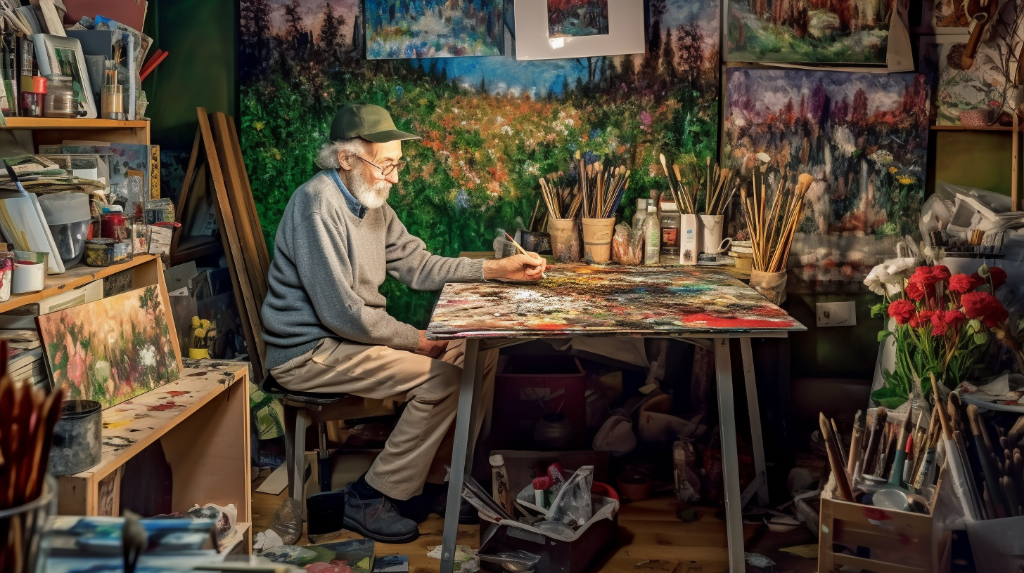How to Make Money as an Artist: A Comprehensive Guide

In a world where creativity is often undervalued, it can be challenging for artists to make a living. However, with the right strategies and a little bit of business savvy, artists can carve out a profitable career path. This comprehensive guide will provide practical tips and insights on how artists can monetize their work and thrive in today’s art world.

Understanding the Art Market
Before an artist can truly succeed, they need to understand the market in which they operate. The art market, like any other, has its own set of rules and nuances. It’s important to understand who your potential buyers are, how they make purchasing decisions, and what type of art is currently popular.
Networking is crucial in the art world. By attending art fairs, exhibitions, and gallery openings, artists can meet potential buyers, learn about the latest trends, and gain a better understanding of the market. This knowledge can help artists make informed decisions about what to create and how to price their work.
Staying up to date with art trends is also important. This doesn’t mean that artists should simply follow the crowd, but understanding what is popular can provide valuable insights. For instance, if abstract art is trending, an artist who specializes in this style may find more opportunities.
Identifying Your Unique Selling Proposition
In a saturated market, standing out is key. One of the ways artists can differentiate themselves is by identifying and showcasing their unique selling proposition (USP).
Your USP is what makes your art different from others. It could be your unique style, the materials you use, the themes you explore, or your personal story. This unique aspect is what can draw buyers to your work and make them willing to pay a premium for it.
For example, if you’re a painter who uses only natural pigments, this could be your USP. Or perhaps you have a unique approach to creating art, such as painting only at night or using unusual tools. Whatever it is, your USP can be a powerful tool for attracting potential buyers and clients.
Monetizing Your Art
As an artist, your creative output is your main product. Thus, finding effective ways to monetize your art is crucial. There are several strategies you can consider, each with its own advantages and drawbacks. These include selling original artworks, prints, and digital copies of your work.
Selling Original Artworks
One of the most direct ways to earn income as an artist is by selling your original artworks. This can include paintings, sculptures, photographs, or any other form of tangible art you create. However, pricing your art can be a complex process. It would help to consider factors like the cost of materials, the time spent creating the work, and the current market prices for similar artworks. You also need to think about where you’ll sell your work. Art galleries, both physical and online, are often the go-to choice, but don’t overlook alternatives like art fairs, open studios, and even your own website.
Selling Prints and Digital Copies
Another way to monetize your art is by selling prints or digital copies of your work. This approach allows you to reach a wider audience and sell multiple copies of a single piece. However, it’s important to ensure that the quality of your prints meets your standards and reflects well on your work. As for digital copies, they can be sold as downloadable files or licensed for use in different mediums. This could be a good way to generate passive income, but be aware that it also means relinquishing some control over how your work is used.
Leveraging Online Platforms
In today’s digital age, online platforms have become a vital tool for artists. They can provide a global reach, allow you to engage directly with your audience, and even simplify the selling process. Below, we’ll discuss some strategies for using online platforms effectively.
Firstly, social media can be an excellent way to showcase your work and connect with potential buyers. Platforms like Instagram and Pinterest are particularly well-suited to visual content. However, it’s important to not just post your work, but also engage with your followers. Respond to comments, post regularly, and consider using features like live videos or stories to give followers a behind-the-scenes look at your creative process.
Online galleries and e-commerce platforms can also be useful for selling art. Websites like Etsy, Saatchi Art, and Artfinder allow you to list your work for sale and reach a global audience. However, these platforms often charge fees, so be sure to factor that into your pricing. Finally, consider setting up your own website. This gives you full control over your online presence and can make it easier for potential buyers to find and purchase your work.
Diversifying Income Streams
One of the most crucial strategies for any artist to make a sustainable living is to diversify their income streams. In other words, don’t put all your eggs in one basket. Why is this so important? Because it provides financial stability. If one source of income dries up, you have others to fall back on.
So, how can an artist diversify their income? There are several ways. Teaching art classes is one of them. This could be in a formal school setting, at a community center, or even online. You can share your knowledge and skills with others while earning a decent income. Plus, teaching can be a fulfilling experience that can enrich your own art practice.
Creating commissioned works is another viable income stream. Many individuals, businesses, and organizations are willing to pay for custom artwork. This could be a portrait, a mural, or a piece of art that complements a specific interior design. It can be a lucrative venture if you’re able to build a solid reputation and client base.
Finally, licensing your artwork can be a steady source of income. This involves selling the rights to use your artwork to a company. In return, you receive a royalty every time the company uses your artwork, such as on a product or in an advertisement.

Understanding Intellectual Property Rights
As an artist, your creations are not just pieces of art; they are also your intellectual property. Therefore, understanding intellectual property rights is crucial to protect your work and earn income from it.
Copyright is the primary form of intellectual property protection for artists. In most countries, copyright is automatic when you create an original piece of art. This means you, as the artist, have the exclusive right to reproduce, distribute, display, and create derivative works from your art.
However, it’s essential to register your copyright to have legal evidence of your ownership. This can be particularly helpful if someone infringes on your rights.
Another aspect of intellectual property rights is licensing. As mentioned earlier, licensing allows you to earn income by granting a company the right to use your artwork in specific ways. This can be a great way to get your art in front of a larger audience while also earning royalties.
Marketing Your Art
As an artist, marketing is a vital part of your business. It’s not enough to simply create beautiful art; you need to get it in front of the right people. Your art won’t sell if no one knows about it.
Building a personal brand is a significant step in marketing your art. Your brand is what sets you apart from other artists and attracts customers. It involves more than just a logo – it encompasses everything from your artistic style to your website design to your interaction with customers. You should aim to create a consistent image that represents your unique perspective and values.
A good portfolio showcases your work and provides a snapshot of your abilities. It should include a range of pieces that demonstrate your skills and versatility. Remember to update it regularly with your latest works.
Promoting your work might mean participating in gallery shows, art fairs, or online exhibitions. Social media can also be a powerful tool for reaching a wider audience. Platforms like Instagram and Pinterest are particularly suited to visual content, making them ideal for artists.
Navigating Financial Aspects
As an artist, you are essentially running a small business, and that means you need to understand the financial aspects of your work. Setting prices for your art is a critical task. Your prices should reflect the time, materials, and effort you put into your work, but they also need to be realistic and competitive. Researching the market and understanding what similar artists charge can help inform your pricing strategy.
Financial management is another crucial aspect of being a professional artist. This includes budgeting, tracking expenses, and managing cash flow. It’s also important to save for taxes, as self-employed individuals are responsible for paying their own tax liabilities.
Understanding taxes for artists can be complex, but it’s an essential part of your financial management. You may be eligible for certain deductions, such as expenses for art supplies or home studio costs. It’s worth consulting with a tax professional to ensure you’re taking advantage of all possible deductions and complying with all applicable tax laws.
| Key Tips for Making Money as an Artist |
|---|
| Understand the art market and stay up-to-date with current trends |
| Identify and showcase your unique selling proposition |
| Monetize your art through various strategies, including selling originals, prints, and digital copies |
| Leverage online platforms to reach a wider audience |
| Diversify your income streams |
- Top Online Platforms for Selling Art
- Etsy
- Artfinder
- Society6
- Artspace
- Saatchi Art
- Essential Tips for Marketing Your Art
- Build a strong personal brand
- Create a comprehensive portfolio
- Promote your work effectively, both online and offline
- Engage with your audience on social media
- Participate in art exhibitions and fairs
In conclusion, while making money as an artist can indeed be a challenging endeavor, it is certainly possible with the right strategies and a proactive approach. This guide provides a comprehensive overview of how artists can monetize their work and succeed in the art world. With persistence, creativity, and business savvy, you can turn your passion into a profitable career.
Get Organized & Win More Clients
Kosmo has everything you need to run your freelancing business.